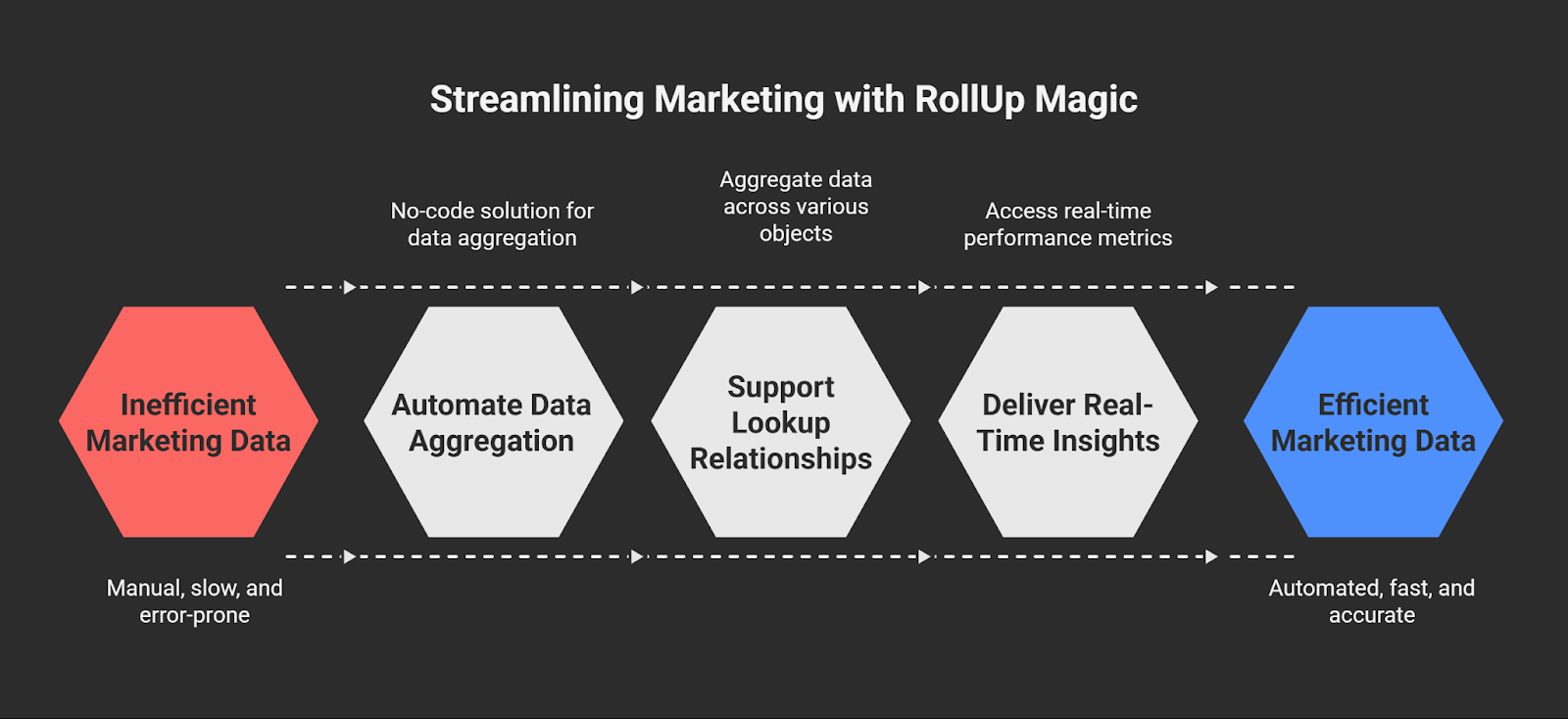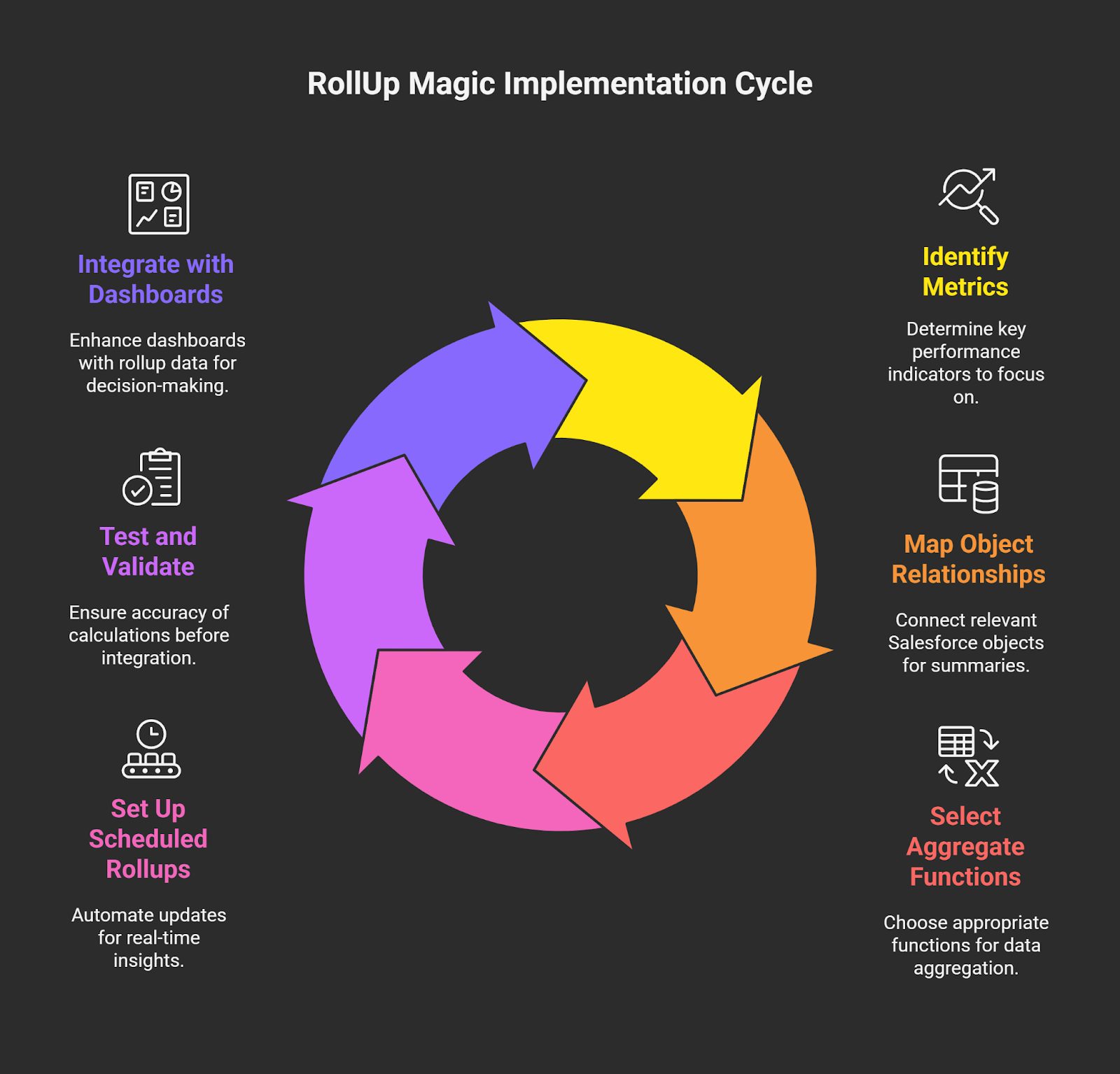Top 5 Ways Marketers Use Rollup Summary Fields for Better Analytics and Data Insights
RollupMagic
5 MIN READ
April 18, 2025
![]()

Marketing teams handle massive volumes of data—from campaign performance and lead generation to customer engagement and revenue attribution. While Salesforce provides a powerful CRM to manage this data, deriving actionable insights often requires complex reports or manual calculations.
This is where rollup summary fields come into play. By automatically aggregating data, rollup summaries help marketers track KPIs like campaign ROI, lead-to-customer conversion rates, and customer lifetime value without manual intervention. However, Salesforce’s standard rollup summaries are limited to master-detail relationships, restricting their use across different objects.
RollUp Magic solves this challenge by enabling rollup summaries across objects with both lookup and master-detail relationships—without requiring code. In this blog, we’ll explore the top use cases for rollup summaries in marketing analytics and how RollUp Magic streamlines data-driven decision-making.
Common Challenges Marketers Face Without RollUp Magic
Marketing teams often deal with fragmented data and time-consuming reporting processes that hinder their ability to make data-driven decisions. Without a tool like RollUp Magic, marketers face several key challenges:
- Manual Data Aggregation: Marketers frequently export data to Excel or other tools to calculate metrics like campaign ROI or conversion rates, a process that can take hours and is prone to errors.
- Limited Relationship Support: Standard Salesforce rollup summaries are restricted to master-detail relationships, leaving marketers unable to aggregate data across Leads, Accounts, or custom objects with lookup relationships.
- Delayed Insights: Manual reporting delays access to real-time performance metrics, slowing down campaign optimization and budget allocation decisions.
- Data Inconsistencies: Relying on manual processes increases the risk of errors, leading to inaccurate reports that undermine confidence in marketing analytics.
Scalability Issues: As marketing teams grow or campaigns become more complex, manual processes become unsustainable, making it harder to scale data-driven strategies.
RollUp Magic addresses these pain points by offering a no-code solution that automates data aggregation, supports lookup relationships, and delivers real-time insights, empowering marketers to focus on strategy rather than manual reporting.
Benefits of Using Rollup Summaries in Marketing Analytics
Marketing teams rely on data-driven insights to optimize campaigns, improve targeting, and maximize ROI. Rollup summaries in Salesforce help marketers consolidate information from multiple records, enabling more efficient analysis and reporting. Here’s how they enhance marketing analytics:
1. Automated Data Aggregation
Rollup summaries eliminate the need for manual data collection and calculations. By automatically aggregating key metrics (such as total revenue, lead engagement, and conversion rates), marketers can focus on strategy rather than spreadsheet work.
2. Real-Time Insights
With rollup summaries, marketing data is updated dynamically, ensuring teams always have real-time performance metrics at their fingertips. This enables faster decision-making and better responsiveness to market trends.
3. Improved Accuracy & Consistency
Manual data entry often leads to errors or inconsistencies. Rollup summaries ensure that marketing reports and dashboards are always accurate, reducing discrepancies and enhancing confidence in the data.
4. Enhanced Reporting & Visualization
Marketers can use accurate data generated through rollup summaries to create more meaningful dashboards and reports in Salesforce. Instead of sifting through individual records, they can visualize aggregated trends, making it easier to spot patterns and optimize marketing strategies.
5. Increased Productivity & Efficiency
By automating data consolidation, rollup summaries save time for marketing teams, allowing them to spend more time on campaign optimization, audience segmentation, and customer engagement rather than manual reporting.
Utilizing RollUp Magic for No-Code Rollup Summary Fields in Marketing Analytics
RollUp Magic is a no-code solution to create custom rollup summary fields in Salesforce By overcoming the limitations of Standard Salesforce rollup summaries, it emerges as a go-to solution for many Salesforce admins users. Its intuitive UI makes it easy to create rollup summary fields, eliminating the need for complex Apex triggers.
1. Tracking Campaign ROI with Automated Revenue Attribution
Use Case: A marketing manager wants to measure the revenue generated by different campaigns to optimize budget allocation.
Without rollup summary: Marketers must manually track which Opportunities originated from a campaign and sum up the total revenue—a tedious process.
With RollUp Magic:
- Automatically roll up the total revenue from Closed-Won Opportunities linked to a Campaign.
- Get instant visibility into high-performing campaigns and allocate budgets accordingly.
- Use SUM and COUNT functions to track total revenue and the number of deals per campaign.
Impact: Marketers gain real-time ROI insights, helping them double down on successful campaigns and cut ineffective ones.
2. Measuring Lead-to-Customer Conversion Rate
Use Case: A marketing analyst wants to track how many leads convert into paying customers to assess lead quality.
Without rollup summary: Marketers manually count converted leads and compare them with total leads—a slow and error-prone process.
With RollUp Magic:
- Use COUNT to track the number of Leads that converted into Opportunities.
- Segment conversion rates by marketing channel, region, or campaign to identify top-performing sources.
- Generate instant reports on lead quality and adjust acquisition strategies accordingly.
Impact: Marketing teams can optimize campaigns by focusing on high-converting lead sources
3. Monitoring Customer Engagement & Retention
Use Case: A retention marketing team wants to track how many repeat purchases existing customers make.
Without rollup summary: Teams must manually check customer records to count repeat transactions, delaying insights.
With RollUp Magic:
- Use COUNT to track the number of repeat purchases per customer.
- Apply SUM to calculate the total revenue from each returning customer.
- Identify high-value customers for loyalty programs or upsell opportunities.
Impact: Marketers can build personalized retention campaigns based on customer purchase behavior.
4. Analyzing Marketing Channel Performance
Use Case: A digital marketing team needs to compare performance across different acquisition channels (Google Ads, LinkedIn, Email, etc.).
Without rollup summary: Marketers manually compile data from different sources and struggle to compare performance.
With RollUp Magic:
- Use SUM and AVERAGE to compare revenue, conversion rates, and engagement levels across channels.
- Track customer lifetime value (CLV) per channel to prioritize high-value traffic sources.
- Automate reporting for faster, data-driven decisions.
Impact: Teams can optimize marketing spending by investing in the most profitable channels.
5. Automating Multi-Touch Attribution Reporting
Use Case: A marketing operations manager wants to track how multiple touchpoints contribute to customer conversion.
Without rollup summary: Marketers struggle to measure the impact of different campaigns and touchpoints in a buyer’s journey.
With RollUp Magic:
- Aggregate data across multiple customer interactions using CONCATENATION to track all touchpoints.
- Assign weighted attribution models to assess the influence of different marketing efforts.
- Gain holistic insights into how customers interact with your brand before making a purchase.
Impact: Marketers can fine-tune their multi-touch strategies for better lead nurturing and conversions.
Why RollUp Magic is a Game-Changer for Marketing Teams
- No-Code Automation: Set up rollup summaries in minutes without coding or IT support.
- Supports Lookup Relationships: Aggregate data across both master-detail and lookup relationships for complete visibility.
- Advanced Aggregate Functions: Go beyond SUM and COUNT with AVERAGE, MAX, MIN, CONCATENATION, and more.
- Real-Time Insights: Get instant updates on marketing performance without waiting for manual reports.
- Scheduled Rollups: Automate data updates at regular intervals to keep analytics dashboards accurate.
- Multi-Object Reporting: Create rollup summary fields that span across Leads, Campaigns, Opportunities, and Accounts for holistic reporting.
Best Practices for Implementing RollUp Magic
To maximize the value of RollUp Magic and streamline your Salesforce marketing analytics, follow these best practices:
- Identify High-Impact Metrics: Start by focusing on key performance indicators (KPIs) like campaign ROI, lead-to-customer conversion rates, or customer lifetime value to ensure your rollup summaries address critical business needs.
- Map Object Relationships: Determine which Salesforce objects (e.g., Leads, Campaigns, Opportunities, Accounts) need to be connected for your rollup summaries. RollUp Magic supports both lookup and master-detail relationships for maximum flexibility.
- Select Appropriate Aggregate Functions: Choose the right function for your needs—use SUM for revenue calculations, COUNT for tracking conversions, or CONCATENATION for aggregating touchpoint data.
- Set Up Scheduled Rollups: Configure automated updates to keep your dashboards and reports current without manual intervention, ensuring real-time insights.
- Test and Validate: Before fully integrating rollup fields into reports or dashboards, verify that calculations are accurate by comparing results with manual checks or existing reports.
Integrate with Dashboards: Use rollup data to enhance Salesforce dashboards, creating visual reports that highlight trends and performance metrics for faster decision-making.
By following these steps, marketing teams can quickly set up RollUp Magic and unlock its full potential for efficient, accurate, and scalable analytics.
Conclusion
Marketing teams thrive on data-driven decisions, but fragmented data and manual reporting slow them down. RollUp Magic eliminates these barriers by automating rollup summaries across Salesforce, helping marketers track campaign ROI, conversion rates, customer engagement, and multi-touch attribution—all without coding.
Ready to transform your marketing analytics? Start using RollUp Magic today and unlock real-time insights for smarter marketing decisions.
Frequently Asked Questions
Q: How long does it take to set up RollUp Magic?
A: RollUp Magic’s intuitive, no-code interface allows marketers and Salesforce admins to create rollup summary fields in minutes, with no coding or IT support required. Most users can set up their first rollup in under 10 minutes.
Q: Does RollUp Magic work with custom Salesforce objects?
A: Yes, RollUp Magic supports both standard and custom Salesforce objects, enabling rollup summaries across Leads, Campaigns, Opportunities, Accounts, and more, regardless of whether they use lookup or master-detail relationships.
Q: Is RollUp Magic secure for sensitive marketing data?
A: Absolutely. RollUp Magic adheres to Salesforce’s strict security standards, ensuring your marketing data is protected and compliant with platform requirements.
Q: Can RollUp Magic handle large datasets?
A: Yes, RollUp Magic is designed to efficiently process large volumes of data, making it suitable for enterprises with complex campaigns or thousands of records.
Q: What kind of support is available for RollUp Magic users?
A: RollUp Magic offers comprehensive documentation, video tutorials, and responsive customer support to guide users through setup, configuration, and troubleshooting.









Author
Share with